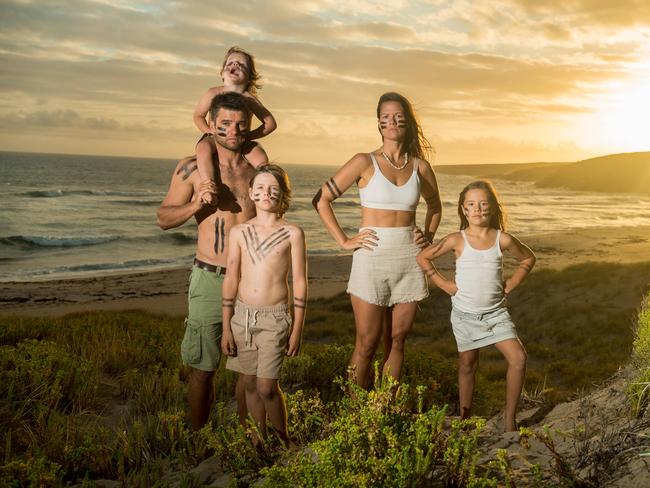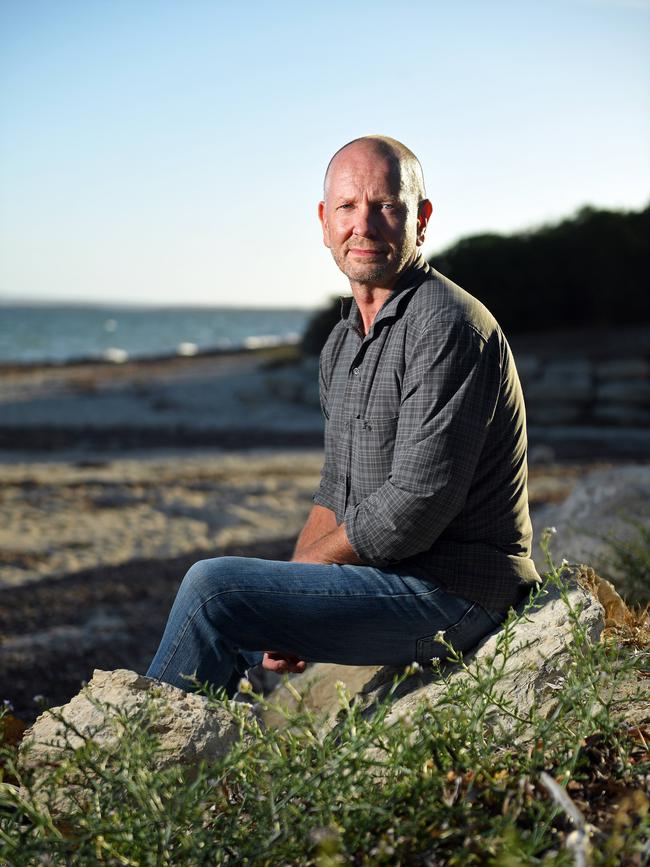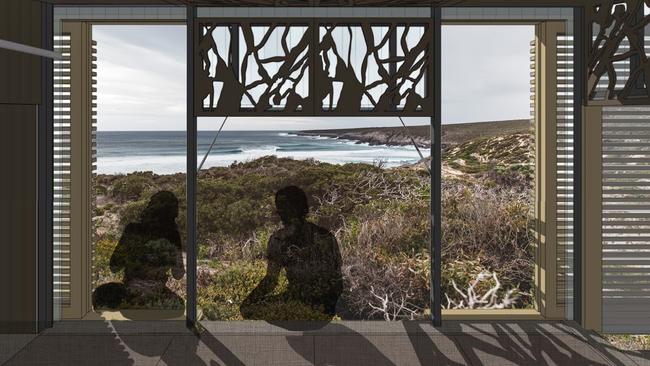Kangaroo Island sleeping pod controversy: Locals gear up to fight development
Kangaroo Island locals are used to the introduction of things that seemed like a good idea at the time. Today, they’re skeptical of sleeping pods in pristine wild lands — and are getting ready for the fight.

SA Weekend
Don't miss out on the headlines from SA Weekend. Followed categories will be added to My News.
Kangaroo Island locals are used to the introduction of things that seemed like a good idea at the time.
For almost a century the island has been treated like a modern day Noah’s ark.
At about 4400sq km, and separated from the Fleurieu Peninsula by 13km of Backstairs Passage, it’s been seen as perfect for protecting at-risk native animals.
First came 18 koalas from Victoria where there were fears for their future — today, there are 25,000 of them (despite sterilisation programs) eating their way through rough barked manna gum and now blue gum plantations introduced for timber.
Then came an entire menagerie: bush turkey, mallee fowl, peacocks, ferrets, deer, pigs, goats and gang cockatoos — all to the detriment of the local environment.
Now local residents are deeply worried about the latest “good idea”.
Another introduced species they say could ruin the beautiful environment — wealthy walkers paying to stop and stay in proposed private accommodation in previously untrampled areas of the island’s Flinders Chase National Park, the jewel in the crown of an island that is seen as the state’s best tourist drawcard.
At the centre of the concerns is a $4 million tourism project, boosted by a state government grant worth $900,000, that would for the first time allow a series of permanent structures — “sleeping pods” and “eco-lodges” — in the celebrated park.
“If this is allowed in one national park, what is to stop it happening in every national park — and then where will my children go to see wild places?” fumes Becky Westbrook, a Kangaroo Island mother and a self-confessed proud ecowarrior as she stands on a headland earmarked for development.
“There are 7.6 billion people in our world and we are developing at a faster rate than ever. How about we keep our national parks wild?”
“If I want to see a building on a headland I can go anywhere else on the island to see that, if I want to see a pristine environment then I will go to a national park … hopefully I will still find a pristine, wild environment there.”
Becky, a born and bred Kangaroo Islander, her farmer husband David, originally from the Yorke Peninsula, and their children Jed, 8, Indi, 6, and Xavier, 3, have joined a grassroots campaign against the proposal arguing their “tribe” are losing a special wild place.
“The government is supposed to be the gatekeepers of our national parks but they are going to let anyone come in and do whatever they want so we have had to stand up and say that it is not OK. We will fight for the wild places.”
The project in question is part of South Australia’s first serious push to get private developers to spruik tourism offerings in protected places like national parks.
It is part of a plan to get more “nature based tourists” — who are known to be happy to spend big, and stay longer — to South Australia.
Proposals have varied wildly from helicopter transport for great white shark tours in the Neptune Islands Conservation Park to conversion of Old Government House in Belair National Park into accommodation.
The Australian Walking Company, which operates award-winning walks in some of the country’s most beautiful areas, is behind the proposal in Flinders Chase.
Under its plans, visitors paying about $2500 a trip will spend each day on foot exploring the remote and unique landscapes of the Kangaroo Island Wilderness Trail.
“Each evening we arrive at our architecturally designed private accommodation along the trail, with our guides preparing sumptuous chef inspired dinners, served with a selection of local wines and beers,” the company website says.

It’s a far cry from the typical dehydrated meals and casked wine most likely being consumed on other parts of the track.
The plan is for 14 two-person “sleeping pods” — which look on the drawings like small cabins — split between two overnight locations.
Each group of seven would be serviced by one “eco-sensitive” lodge.
On the third night guests would stay in upgraded historic lighthouse keeper’s cottages at Cape du Couedic.
It is the accommodation on the first two nights, and the additional roads and paths that will be required for the new buildings, that have opponents of the project seeing red, not green.
The infrastructure will be placed on prominent headlands, kilometres away from the celebrated Flinders Chase Trail.
Locals say they have been blindsided by the process, arguing they thought the project would be established near the existing track.
Their concerns, though, may mean little.
The work does not have to go through a public consultation process, courtesy of rules established by the former Labor Government and embraced by the Marshall Government.
Legal action is pending but the State Government is confident the project will go ahead.
It’s a warm autumn morning at Sandy Bay, and a slight breeze whips across an exposed headland dotted with native daisies, creeping myoporum and indigenous succulents.
It’s here, on a cliff above a churning sea that sends waves crashing into rocks and soft white sand, that is the proposed site of the first night of accommodation.
With their backs to the Southern Ocean — next stop Antarctica — Colin Wilson and Nirbeeja Saraswayi are on the lookout for surveyors stakes to highlight how far the proposed development will stretch across the headland.
Earlier the pair were treading carefully on the soft sand of what would, in winter, be a creek.
They were searching for hooded plovers that are believed to have created shallow nests nearby. They want to make sure the vulnerable birds are safe.
Strictly speaking they should not be looking out for the birds.
As members of the local Friends of National Parks group — teams of volunteers that dedicate hundreds of man hours every year helping to preserve the state’s protected areas — they are supposed to be on strike in protest against the proposed development.
It is not a decision they have made without much soul searching.
The Western Districts branch they belong to was set to celebrate its 100 year anniversary in October.
It has declared that they will be taking no part and have been urging other groups around the state to do the same. A number have joined them.
Wilson, a former ecologist, understands the impact the strike could have but he wants to send a clear message to the environment department and State Government.
“We do weed control, track maintenance, beach cleanups and revegetation,” Wilson says.
“There are several trays of seedlings sitting in the Kangaroo Island nursery which we would have been planting next month in Flinders Chase as part of the revegetation of campsites along the trail. If we don’t do this work nobody else will do it. There is not enough parks staff.”
Colin’s partner Bev Maxwell, who has a background in education and communications, is the spokeswoman for the Friends group.
She says the groups are “not just about weeds and seeds”, adding a lot of the work they do is focused on community education and awareness campaigns “to promote the values of the park.”
Maxwell does not join SAWeekend for a walk to the headland.
She is busy at home in Kingscote preparing for a public meeting that night and a rally on the steps of state parliament a week later.
At the two public meetings, one in Parndana and the other in Kingscote, more than 100 people listen to Department of Environment staff and Australian Walking Company general manager Heath Garratt explain the plans.
Many of the questions are delivered with anger and cynicism. At one point AWC’s architect for the project, award-winner Adrian Welke, is told to sit down.
Concerns from locals range from the accommodation and infrastructure to fears the department of environment is turning its back on its core duty — to protect these spaces.
Much of the concerns centre around what might be next. “It’ll be the Gold Coast before you know it,” one argues.
Another claims the project has been given tens of thousands of taxpayers dollars so “very wealthy people can have footbaths and drink chardonnay.”

Garratt, the man behind the project, says he gets the concerns of the Westbrooks and other residents.
But the softly spoken Tasmanian does his best to allay their concerns, walking a fine line between a need to protect commercial and operating aspects of KI project while being upfront about the concerns.
A few weeks later talking, from his office in Hagley, Tasmania, the former nurse who started his career at the company as a tour guide describes himself as a conservationist.
“I know that does not sit well with some but I wouldn’t be doing now what I am doing otherwise,” he says.
“In a lot of respects I would rather be out there with the guests treading the tracks but I am passionate enough to go through these tricky times that we are experiencing at the moment in the interests in getting more people out there and having these really meaningful experiences.”
He believes exposing more people to wild areas like the Flinders Chase National Park is the best way to raise awareness of the environmental values of these areas.
The company knows success.
In 2015 Virgin Australia co-founders and Tasmanian Walking Company owners Rob Sherrard and Brett Godfrey joined forces with former Qantas boss Geoff Dixon and investment banker Scott Malcolm, to create the Australian Walking Company in a bid to take its successful business model that had been established in the Apple Isle across the country.

The Cradle Mountain Huts Walk, which uses the iconic Tasmanian Overland Track, opened in 1987 and paved the way for another four experiences on the island taking in some of the state’s best known locations including Bruny Island, Freycinet and Bay of Fires.
Four other projects are earmarked for the state.
The company also runs The Twelve Apostles Lodge Walk, running parallel to Victoria’s Great Ocean Road, and Queensland is in its sights.
But the products have been criticised as elitist.
“The majority of our guests would not go there if it were not for being able to have a light pack, a comfortable mattress at night and higher service levels like food and the wilderness interpretation that the guides offer,” Garratt says.
“To run these walks well it does cost a lot as a business. There are a lot of hidden costs. For that reason we charge our guests a lot.”
He denies suggestions that AWC has previously spruiked the project to locals and the former government as being closer to the trail.
The trail is a 61 kilometre five-day trek that weaves through the most botanically unique area in South Australia before reaching the spectacular coastline.
The AWC project will traverse the same trail, but deviate to accommodation nodes on two nights and the lighthouse on the last, instead of providing accommodation on five nights.
“We have always had the approach that we wanted to be away from roads, we wanted to be away from the parks site and for mutual interest we wanted to be away from the wilderness trail as well,” he insists.
“That has always been our focus.”
Mr Garratt says the grant was awarded after his second attempt.
“A lot of these grants often go to … not sustainable industries so I think it is great that it is going to what is a more sustainable industry in tourism.”
The company will have to reach particular milestones, including creating a certain number of jobs, before they get paid the grant.
“It is not just a hand out.”
He says the company will employ 30 full time equivalent staff once up and running. It will also have to pay the State Government a percentage of revenue from the walk and a rental fee for the use of the lighthouse cottages.
“Our preference is that it goes directly back into the park we are operating in so the locals can see the direct benefits,” he says.
It is not hard to see why Kangaroo Island has been chosen for the company’s next project.
When Hollywood superstar Chris Hemsworth, aka Thor, was recruited in early 2018 as part of Tourism Australia’s cheeky Crocodile Dundee reboot project Kangaroo Island featured prominently.
As he spent quality family time on Kangaroo Island meeting the locals — swimming with dolphins, cuddling koalas and checking out sea lions — he was sharing the pictures to more than 14 million followers on his Instagram account.
But some believe the government are at risk of going too far.
South Australian Greens MP Mark Parnell has no doubt.
“If you go back many years there was a general recognition Kangaroo Island could actually attract more visitors if they expanded the range of opportunities,” he said.
“But underlying that thinking was not to kill the goose that laid the golden egg, not to sacrifice the qualities that people came to Kangaroo Island for.”
Mr Parnell said the AWC plans are of inappropriate scale, construction and location but because it is a tourism development it is regarded as a category one development which means there is no public consultation “and they don’t have to show you the plans.”
“It is public land, it is a national park, it is land held on trust for the people of South Australia,” he said.
“If they are going to consider approving developments in national parks then they have to bring the people of South Australia with them.
“It is inconceivable that we should not be able to see those plans.”

South Australian environment minister David Speirs was not the architect of the push into more nature based tourism projects — it was the former Labor government.
But he has embraced the policy.
“About $1.3 billion of visitor expenditure in South Australia can be attributed to nature-based tourism and it’s growing,” Speirs says.
“We want to ensure that nature-based tourism keeps contributing to the visitor economy so that it helps us to look after our special places, continues to keep South Australians employed and keeps inspiring visitors from South Australia and around the world.”
He says the department and government “will learn from the Kangaroo Island situation” and “we will endeavour to work more closely with the community including the Friends groups”.
“We will be assessing these projects against their environmental impact their social benefits and their economic uplift.
“And we will be much more thorough about how we work alongside communities.”
Speirs’ comments will give little comfort to the Kangaroo Island community protesting against the project in Flinders Case.
The Minister is quite sure the project will go ahead despite a threat of pending legal action.
“The government is confident that everything that has been worked through thus far has followed the correct processes and where we have landed is at a place that is legally sound,” he says.
But what does he makes of the accusations of secrecy?
“There will always be commercial-in-confidence matters involved in these sorts of projects,” he says.
“That is inevitable and it occurs with all governments but I do think it comes down to the engagement with the community and what they want to see in the community.
Luke Martin, the chief executive of the Tourism Industry Council Tasmania, has seen similar battles play out in his home state.
Last week the Tasmanian Wilderness Society launched Federal Court action against a proposed helicopter-accessed, luxury tourist accommodation on Halls Island, Lake Malbena, in Walls of Jerusalem National Park, within the Tasmanian Wilderness World Heritage Area (TWWHA).
Martin, as head of the lobby group long regarded as the most influential in the island state, has found himself defending the Tasmanian government’s policy for developing private enterprise in national parks.
But he says three decades of encouraging people to pay a premium for experiencing places like Tasmania’s World Heritage Areas has been a booming success.
“Every state is looking at Tasmania’s success in nature tourism and wanting to replicate it,” Martin says.
“We know that we are in a world that is increasingly going to value, and put a premium on, exceptional nature tourism, exceptional natural environments and pristine environments.
“And as a community, and a society, we should not be afraid to offer a premium way for people to actually experience those environments.
“The scrutiny on these projects is important. We should not be afraid to have really heated debates. But at the same time we should not be afraid of taking the lead forward and creating these opportunities and putting a premium value on these areas because that is ultimately how we build the case for more conservation.”
But on Kangaroo Island Bev Maxwell sums up the sentiments of locals who have not seen such a process before.
“There is a real change in ethos,” she says. “National Parks are certainly for people’s involvement and enjoyment but national parks have a really strong conservation element.
“When we start changing that emphasis for our national parks from conservation to recreation … that is not the point of what they should be.
“When the conservation and environmental values becomes secondary to economic, that is undermining the ethos of what national parks are supposed to be about.
“And if it can happen at Flinders Chase it can happen anywhere.”


